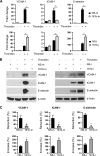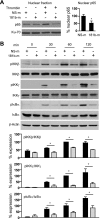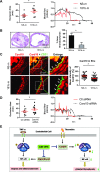MicroRNA-181b inhibits thrombin-mediated endothelial activation and arterial thrombosis by targeting caspase recruitment domain family member 10
- PMID: 27297585
- PMCID: PMC5001512
- DOI: 10.1096/fj.201500163R
MicroRNA-181b inhibits thrombin-mediated endothelial activation and arterial thrombosis by targeting caspase recruitment domain family member 10
Abstract
Thrombogenic and inflammatory mediators, such as thrombin, induce NF-κB-mediated endothelial cell (EC) activation and dysfunction, which contribute to pathogenesis of arterial thrombosis. The role of anti-inflammatory microRNA-181b (miR-181b) on thrombosis remains unknown. Our previous study demonstrated that miR-181b inhibits downstream NF-κB signaling in response to TNF-α. Here, we demonstrate that miR-181b uniquely inhibits upstream NF-κB signaling in response to thrombin. Overexpression of miR-181b inhibited thrombin-induced activation of NF-κB signaling, demonstrated by reduction of phospho-IKK-β, -IκB-α, and p65 nuclear translocation in ECs. MiR-181b also reduced expression of NF-κB target genes VCAM-1, intercellular adhesion molecule-1, E-selectin, and tissue factor. Mechanistically, miR-181b targets caspase recruitment domain family member 10 (Card10), an adaptor protein that participates in activation of the IKK complex in response to signals transduced from protease-activated receptor-1. miR-181b reduced expression of Card10 mRNA and protein, but not protease-activated receptor-1. 3'-Untranslated region reporter assays, argonaute-2 microribonucleoprotein immunoprecipitation studies, and Card10 rescue studies revealed that Card10 is a bona fide direct miR-181b target. Small interfering RNA-mediated knockdown of Card10 expression phenocopied effects of miR-181b on NF-κB signaling and targets. Card10 deficiency did not affect TNF-α-induced activation of NF-κB signaling, which suggested stimulus-specific regulation of NF-κB signaling and endothelial responses by miR-181b in ECs. Finally, in response to photochemical injury-induced arterial thrombosis, systemic delivery of miR-181b reduced thrombus formation by 73% in carotid arteries and prolonged time to occlusion by 1.6-fold, effects recapitulated by Card10 small interfering RNA. These data demonstrate that miR-181b and Card10 are important regulators of thrombin-induced EC activation and arterial thrombosis. These studies highlight the relevance of microRNA-dependent targets in response to ligand-specific signaling in ECs.-Lin, J., He, S., Sun, X., Franck, G., Deng, Y., Yang, D., Haemmig, S., Wara, A. K. M., Icli, B., Li, D., Feinberg, M. W. MicroRNA-181b inhibits thrombin-mediated endothelial activation and arterial thrombosis by targeting caspase recruitment domain family member 10.
Keywords: Card10; NF-κB; endothelial cells.
© FASEB.
Figures






References
-
- Jackson S. P. (2011) Arterial thrombosis--insidious, unpredictable and deadly. Nat. Med. 17, 1423–1436 - PubMed
-
- Barua R. S., Ambrose J. A. (2013) Mechanisms of coronary thrombosis in cigarette smoke exposure. Arterioscler. Thromb. Vasc. Biol. 33, 1460–1467 - PubMed
-
- Henry P. D., Cabello O. A., Chen C. H. (1995) Hypercholesterolemia and endothelial dysfunction. Curr. Opin. Lipidol. 6, 190–195 - PubMed
-
- Furie B., Furie B. C. (1988) The molecular basis of blood coagulation. Cell 53, 505–518 - PubMed
Publication types
MeSH terms
Substances
Grants and funding
LinkOut - more resources
Full Text Sources
Other Literature Sources
Research Materials
Miscellaneous

